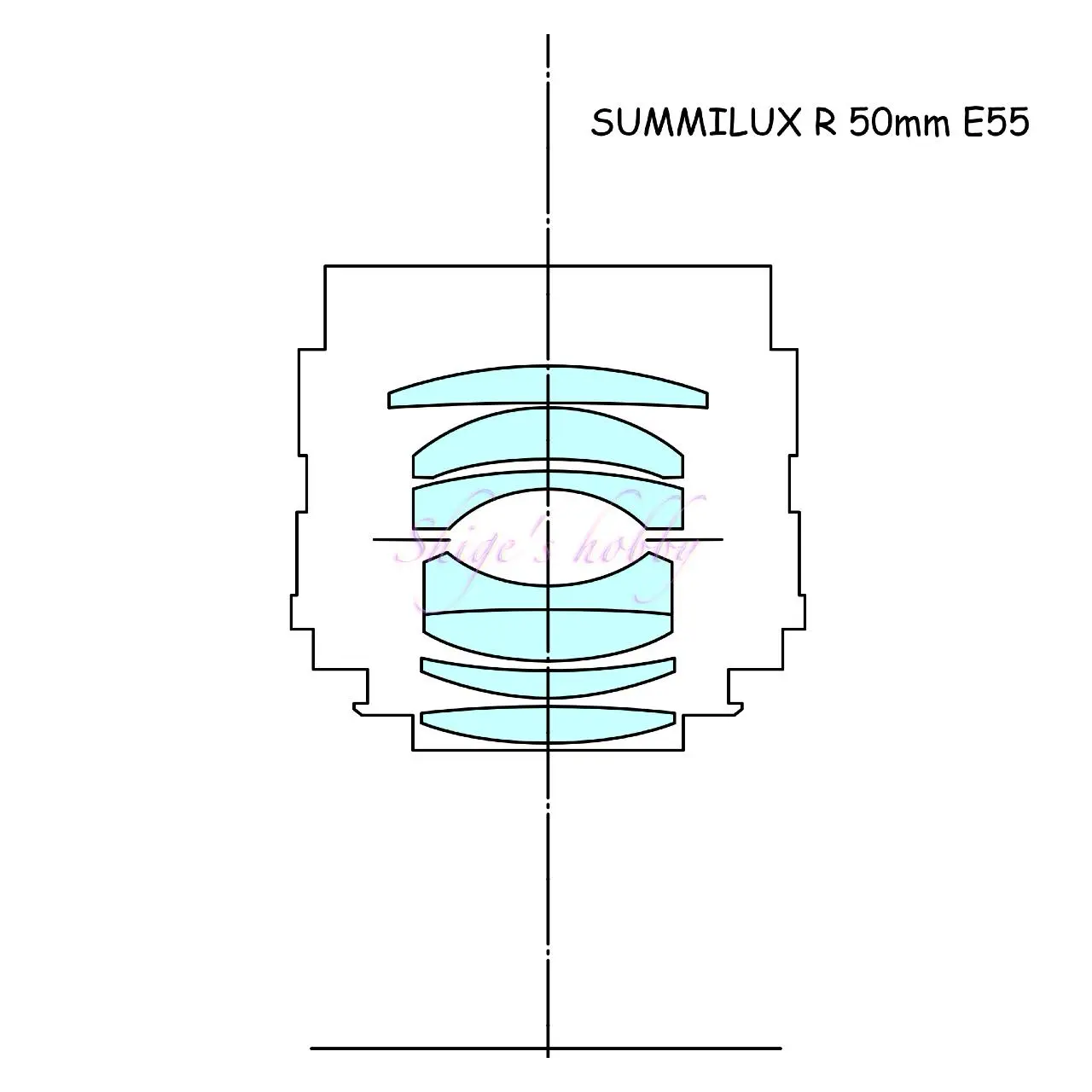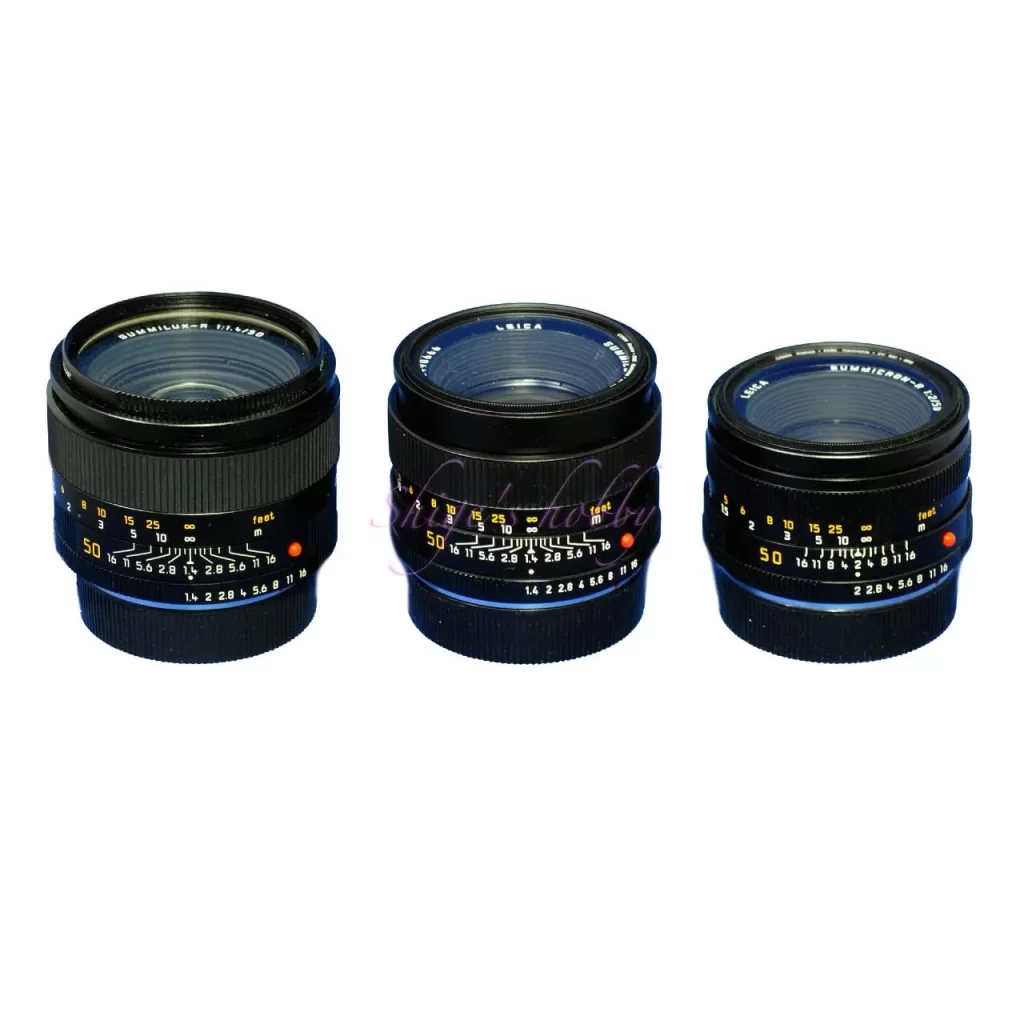Last updated on 2025-10-17
A review and sample photos of the new LEICA SUMMILUX R 50mm F1.4 E60, Type II, used with film and digital cameras.
- Please see the disclaimer regarding advertising here.
- Italicized links in the text are advertisement links that take you to other sites.
Table of contents
Gallery
The following cameras were used to take the sample photos:
- LEICA R8 +KODAK GOLD200 & KODAK ProImage100
- LEICA R8 +DMR(Digital Module R)
- CANON EOS 1Ds Mk-III & CANON EOS-1D Mark-IV
- LEICA SL Typ601 & LEICA CL
- SONY α7Sii
Review


1.Overview
The LEICA SUMMILUX R 50mm f/1.4 E60 (new model, Type II) is a large-aperture standard lens for the Leica R mount, released in 1997, towards the end of the Leica R mount’s lifespan.
This lens’s optical design has been changed from the previous Summilux model to 8 elements in 7 groups to improve image quality. The main changes are a 60mm filter diameter, a larger front element, and an additional element between the front and rear groups. The previous Summilux R 50mm E55 has a 6 elements in 5 groups and a 55mm filter diameter.
This lens does not use aspherical lenses, and I have only ever seen it in versions with R-CAM and ROM connectors. Given the production period, it is assumed that 3-CAM versions did not exist. Approximately 2,700 lenses were produced.
The last spherical Summilux M was released in 1992, so this lens, released in 1997, was the last spherical Summilux 50mm.
2.Usability
The LEICA SUMMILUX R 50mm F1.4 E60 was made during the film camera era. However, I’m satisfied with the image quality when using it with a digital camera. The lens I own is a 382xxxx, manufactured in 1998, the year this lens was most widely produced.
The gallery displays results from both film and digital cameras. Looking at both results, you’ll see the lens’s balance of sharpness and softness.
The hood doesn’t extend very much, just a little. Even so, the lens’s resistance to backlight is excellent, so I rarely had any issues with lighting conditions when shooting.
This lens occasionally pops up on Yahoo! Auctions and eBay, but it commands a fairly high price.
I’ll describe my experience using it with each camera.
■LEICA R8 +KODAK GOLD200 & KODAK ProImage100
When I used it with a LEICA R8 and negative film, it matched well with the coarse grain of the negative film. Judging from the results with negative film, it seems like the unique softness and sharpness of the image can be enjoyed even when used in monochrome.
The LEICA R8 film camera can focus easily at widest aperture using a standard universal screen (14343).
■LEICA R8 + DMR (Digital Module R)
Images taken with the LEICA SUMMILUX R 50mm E60 using the Digital Module R are cropped by 1.37 times the displayed focal length because the camera’s image sensor is smaller than that of 35mm film. A focal length of 50mm is equivalent to a focal length of 68.5mm in 35mm format.
By cutting out the peripheral areas, where roughness is more visible with a digital camera, higher-resolution images are obtained. The gradations of the sunset are also beautifully depicted.
Although the LEICA SUMMILUX R 50mm E60 is a large-aperture f/1.4 lens, I had no trouble focusing using the DMR’s standard universal screen (14392). There were almost no situations where I needed the separately sold microprism screen, which improves central focus accuracy.
The DMR’s dedicated focusing screen has a square frame on the inside to indicate the shooting range, as it is designed to fit a sensor size smaller than 35mm film.
When a DMR is used with a lens that has a ROM terminal, the focal length, aperture setting, and other information are recorded in the Exif information. In the example below, we can see that the photo was taken at a focal length of 50mm and a wide-open aperture of f/1.4. Depending on the lens, the focal length or aperture may not be conveyed, revealing a discrepancy in specifications as Leica moves between the analog and digital eras.

■CANON EOS 1Ds Mk-III & CANON EOS-1D Mark-IV
I was able to use this lens without any issues with both the EOS-1 Ds MKIII, which is equipped with a 35mm full-frame sensor, and the EOS-1D Mark-IV, which is equipped with an APS-H size sensor.
Since the EOS series is generally designed for autofocus, it’s easier to capture the focus peak when using manual focus on high-end MINOLTA α cameras. However, with the SUMMILUX R 50mm, I had no issues focusing using the standard screens on the EOS-1 Ds MKIII and EOS-1D Mark-IV.
In terms of image quality, the 20-megapixel EOS-1 Ds MKIII has no issues at all, and the EOS-1D Mark-IV, which has a smaller sensor size, only uses the central portion of the lens, resulting in better image quality. However, the APS-H size sensor on the EOS-1D Mark-IV cuts off the edges compared to 35mm film, resulting in a longer focal length. The coefficient of the focal length converted to 35mm format is 1.3 times, so a SUMMILUX with a focal length of 50mm becomes a lens equivalent to 65mm.
■LEICA SL Typ601 & LEICA CL
The LEICA SL typ601 has a 24-megapixel 35mm full-frame sensor, which is about 20% more pixels than the Canon EOS 1Ds MK-III. The 20% increase in pixels is barely noticeable.
The LEICA CL has an APS-C sensor, which is smaller than 35mm film, and is converted to 35mm film equivalent by a factor of 1.5. This means that this lens, with a focal length of 50mm, is equivalent to a focal length of 75mm in 35mm film, making it a medium telephoto lens.
Both cameras are equipped with 24-megapixel sensors, and although the sensor sizes are different, both offer fully usable resolution and sharp edges.
When using the digital mirrorless Leica SL typ601 with Leica’s original mount adapter, the Leica R-Adapter L (16076), focal length, aperture, and other information are recorded in EXIF. This is extremely useful for lazy people who don’t take notes.
However, the ROM information for the new SUMMILUX R 50mm appears to be the same as that of the old SUMMILUX R 50mm, so it is not possible to determine whether the lens is new or old from the information recorded in Exif.
With mirrorless cameras that can use EVFs, the focus point magnification function eliminates the concerns about focus point that can be a bit of a worry with SLR cameras.

■SONY α7Sii
The SONY α7, α9, and α1 series are equipped with 35mm full-frame sensors, but unlike SLR cameras, they do not have a mirror that interferes with the lens, so they can easily use Leica R-mount lenses.
The SONY α7Sii is equipped with in-body image stabilization and has a relatively low pixel count of 12 megapixels, making it easy to use LEICA R lenses. The α7Sii cannot reflect manually entered focal lengths in Exif data. To record them, a separately sold “Lens Correction” app is required, but this is no longer on sale.
I would like to think that this has been improved in successor cameras, but from what I’ve researched, this does not seem to be the case.
There is software available that allows you to add focal lengths to Exif data via command line, so it looks like you’ll have to use that.
3.Summary
In conclusion, to sum up the SUMMILUX R 50mm E60, the lens barrel has been changed to the latest Leica R E60, making it a little thicker and heavier. However, it is still compact enough compared to retrofocus standard lenses from the 2020s.
The image quality also lacks the sharp resolution and clarity of the latest retrofocus standard lenses, but when you look at the results, you’ll find that the exquisite balance is addictive.
Specifications, considerations, etc.
Comparing the old and new SUMMILUX R 50mm, the new model has a slightly larger diameter and an additional lens in the center. The larger diameter is to increase the amount of light around the edges, and the additional lens in the center is thought to be for aberration correction.


| Items | SUMMILUX R E55 | SUMMILUX R E60 |
| focal length(mm) | 50 | 50 |
| Maximum aperture | 1.4 | 1.4 |
| Minimum aperture | 16 | 16 |
| Aperture blade | 6 | 8 |
| Lens Construction | 7elements in 6groups | 8elements in 7groups |
| Min distance(m) | 0.5 | 0.5 |
| Lens length(mm) | 50.6 | 51 |
| Lens Max diameter(mm) | 68.5 | 70 |
| Filter Size(mm) | 55 | 60 |
| Weight(g) | 395 | 490 |
| Release date | 1989~1995(Model 1777) | 1997~2005 |
| Production numbers | 4,149(Late) 35,322(Early+Late) | 2,700 |
The comparison photo below shows, from left, the SUMMILUX R50-E60, the SUMMILUX R50-E55, and the SUMMICRON R50-E55.
The SUMMILUX R50-E60 is the largest and heaviest because it has the most lenses.

Reference links
- All about the R-type Leica / Author: Shinichi Nakamura / Edited by Asahi Sonorama Ads by Amazon
- SUMMICRON-R 50mm F2 Leica wiki
- LEICA Wiki SUMMILUX-R 50mm F1.4 E55
- LEICA Wiki 50mm f/1.4 Summilux-R II E60
- LEICA Wiki 「SUMMILUX 1.4/50-3rd」
Affiliate link

Amazon Prime Sale
Update history
- 2025.10.8
- 2025.5.14
- 2024.12.16
- 2024.02.20
- 2022.04.14



Be First to Comment